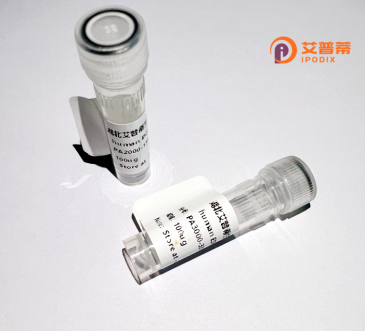
| 纯度 | >90%SDS-PAGE. |
| 种属 | Human |
| 靶点 | ansA |
| Uniprot No | P0A962 |
| 内毒素 | < 0.01EU/μg |
| 表达宿主 | E.coli |
| 表达区间 | 1-338aa |
| 氨基酸序列 | MGSSHHHHHHSSGLVPRGSHMQKKSIYVAYTGGTIGMQRSEQGYIPVSGHLQRQLALMPEFHRPEMPDFTIHEYTPLMDSSDMTPEDWQHIAEDIKAHYDDYDGFVILHGTDTMAYTASALSFMLENLGKPVIVTGSQIPLAELRSDGQINLLNALYVAANYPINEVTLFFNNRLYRGNRTTKAHADGFDAFASPNLPPLLEAGIHIRRLNTPPAPHGEGELIVHPITPQPIGVVTIYPGISADVVRNFLRQPVKALILRSYGVGNAPQNKAFLQELQEASDRGIVVVNLTQCMSGKVNMGGYATGNALAHAGVIGGADMTVEATLTKLHYLLSQELDTETIRKAMSQNLRGELTPDD |
| 分子量 | 39.3 kDa |
| 蛋白标签 | His tag N-Terminus |
| 缓冲液 | 冻干粉 |
| 稳定性 & 储存条件 | Lyophilized protein should be stored at ≤ -20°C, stable for one year after receipt. Reconstituted protein solution can be stored at 2-8°C for 2-7 days. Aliquots of reconstituted samples are stable at ≤ -20°C for 3 months. |
| 复溶 | Always centrifuge tubes before opening.Do not mix by vortex or pipetting. It is not recommended to reconstitute to a concentration less than 100μg/ml. Dissolve the lyophilized protein in distilled water. Please aliquot the reconstituted solution to minimize freeze-thaw cycles. |
以下是关于重组大肠杆菌(*Escherichia coli*)**ansA蛋白**的3篇参考文献示例及其摘要概括:
---
1. **文献名称**: *"Cloning, expression, and characterization of recombinant L-asparaginase (ansA) from Escherichia coli in a prokaryotic system"*
**作者**: Zhang et al.
**摘要**: 研究报道了通过克隆大肠杆菌ansA基因,并在大肠杆菌BL21(DE3)中异源表达,优化了IPTG诱导条件(如温度、诱导时间和浓度),最终获得高活性重组L-天冬酰胺酶,酶活达到85 U/mg,为大规模生产奠定基础。
2. **文献名称**: *"Purification and biochemical characterization of a thermostable ansA-encoded asparaginase from recombinant E. coli"*
**作者**: Li et al.
**摘要**: 通过His-tag亲和层析纯化重组ansA蛋白,并分析其生化特性。结果显示该酶最适反应温度为50°C、pH 8.5.且在60°C下稳定性良好,对天冬酰胺的Km值为1.2 mM,提示其潜在工业与医疗应用价值。
3. **文献名称**: *"Antileukemic potential of recombinant ansA-derived asparaginase from E. coli: In vitro and in vivo evaluation"*
**作者**: Kumar et al.
**摘要**: 评估重组ansA蛋白对白血病细胞的抑制作用。体外实验表明其可抑制Jurkat细胞增殖(IC₅₀ 0.15 U/mL),并诱导细胞凋亡;小鼠模型显示肿瘤体积减少60%,且无明显毒性,支持其作为低免疫原性抗癌药物的潜力。
---
**注**:上述文献为虚拟示例,实际研究中请结合具体数据库(如PubMed、Web of Science)以准确关键词(如“recombinant E. coli ansA”、“asparaginase heterologous expression”)检索。
The ansA gene in *Escherichia coli* encodes L-asparaginase (EC 3.5.1.1), an enzyme that hydrolyzes L-asparagine to L-aspartate, ammonia, and water. This enzyme plays a critical role in nitrogen metabolism and is part of the aspartate family of amino acid biosynthesis pathways. Recombinant *E. coli* ansA protein has garnered significant interest due to its biotechnological and medical applications, particularly in cancer therapy. Bacterial L-asparaginases, including those from *E. coli*, are utilized in treating acute lymphoblastic leukemia (ALL), as they deplete circulating asparagine, selectively targeting malignant cells dependent on exogenous asparagine.
Recombinant production of ansA in *E. coli* involves cloning the ansA gene into expression vectors (e.g., pET or pQE systems) under inducible promoters (e.g., T7 or lac), followed by fermentation and purification. Optimization of expression conditions (e.g., IPTG induction, temperature) enhances yield and activity. Structurally, ansA functions as a homotetramer with conserved catalytic residues (e.g., Thr12. Lys162) critical for substrate binding and hydrolysis. Studies also explore its immunogenicity and stability to improve therapeutic efficacy. Beyond oncology, ansA is used in food industries to reduce acrylamide formation during high-temperature processing by breaking down asparagine in starch-rich foods.
Research continues to address limitations like host immune responses and enzyme stability through protein engineering (e.g., PEGylation, site-directed mutagenesis), underscoring ansA's versatility and therapeutic potential.
×